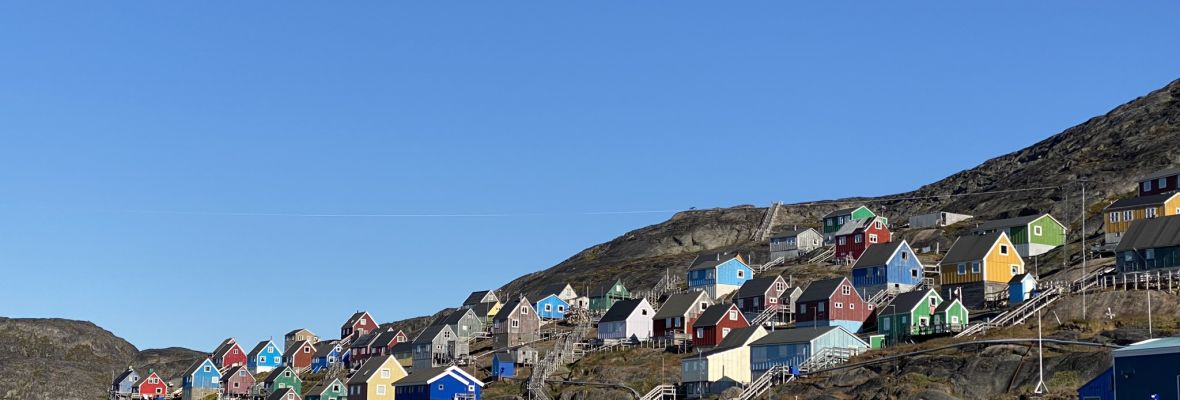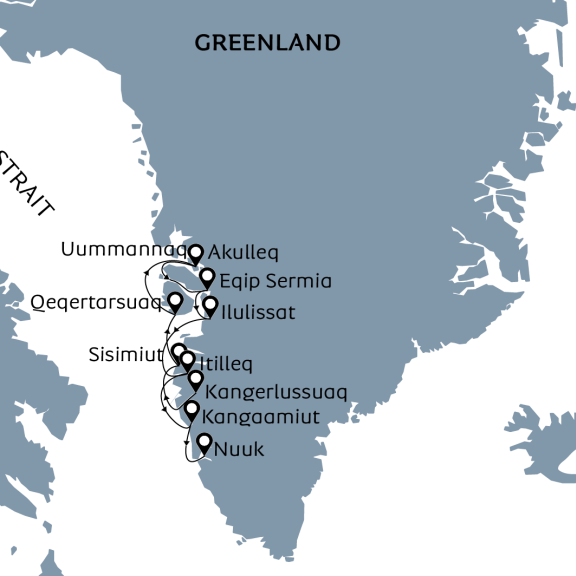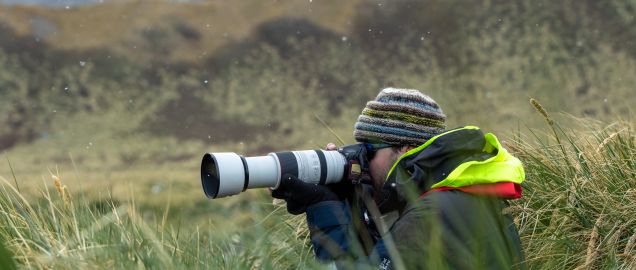Complete West Greenland
Next DepartureSep. 5, 2026See all departures |
Duration10 daysSee the itinerary |
Activities
, Kayaking, Lectures, Zodiac |
Experience the best of Greenland on this thrilling itinerary, new for 2026!
From the icebergs of Ilulissat, to the skyscrapers of Nuuk. From the glaciers of Evighedsfjorden to the mountains of Uummannaq. From the cosy hospitality of Itilleq to the otherworldly rock formations of Kuannit, this voyage showcases the best that Greenland has to offer.
Embark our state of the art vessel Ocean Albatros for a thrilling voyage covering the highlights of Greenland's West Coast, beginning in the airport town of Kangerlussuaq. Travelling by sea is without doubt the best way to experience Greenland, where life has been governed by the waves, ice and tides since time immemorial. From colourful coastal villages to bustling miniature cities, glaciers and icebergs to fjords and towering mountains, we combine the highlights of this magnificent land into one epic voyage.
Even in the larger towns we visit, Arctic nature is never far away. A few minutes walk away from the colourful houses, visitors can find themselves utterly alone, surrounded by wilderness - a rarity in our busy modern world. Life in Greenland moves at a different pace, following the rhythms of the sea, the tides and the midnight sun. The local culture, architecture and lifestyle are all governed by the harsh yet beautiful conditions of the Arctic. During the voyage, meet the friendly locals of Greenland and discover more about their ancient culture.
Our adventure begins in Greenland's transport hub of Kangerlussuaq, before visiting nearby Sisimiut, Greenland's bustling second city. From here we venture northwards, to the sweeping basalt mountains and weird rock formations of Qeqertarsuaq, and onwards to spend two days exploring Uummannaq and is vast surrounding fjordlands. We then head southwards into the heart of Disko Bay, witnessing the astounding spectacle of Eqip Sermia Glacier, before arriving in Ilulissat, home of the UNESCO World Heritage Site of Ilulissat Icefjord. From the icy waters of Disko Bay, we will visit the small village of Itilleq, where visitors can experience the hunting and fishing traditions by which locals still thrive. Next, we will visit the artistic community of Kangaamiut and the breathtaking glaciers of Evighedsfjorden, before disembarking in the vibrant Greenlandic capital city of Nuuk.
Utilising Ocean Albatros' fleet of Zodiacs, nowhere is off limits to us. With the ability to land in small villages or lonely beaches, we can access even the most remote locations. Witness Arctic nature from the superlative comfort of Ocean Albatros, as we follow the whales and seals along the coast of this breathtaking land. Experience with us!
Facts about Complete West Greenland
- Arctic
- Greenland
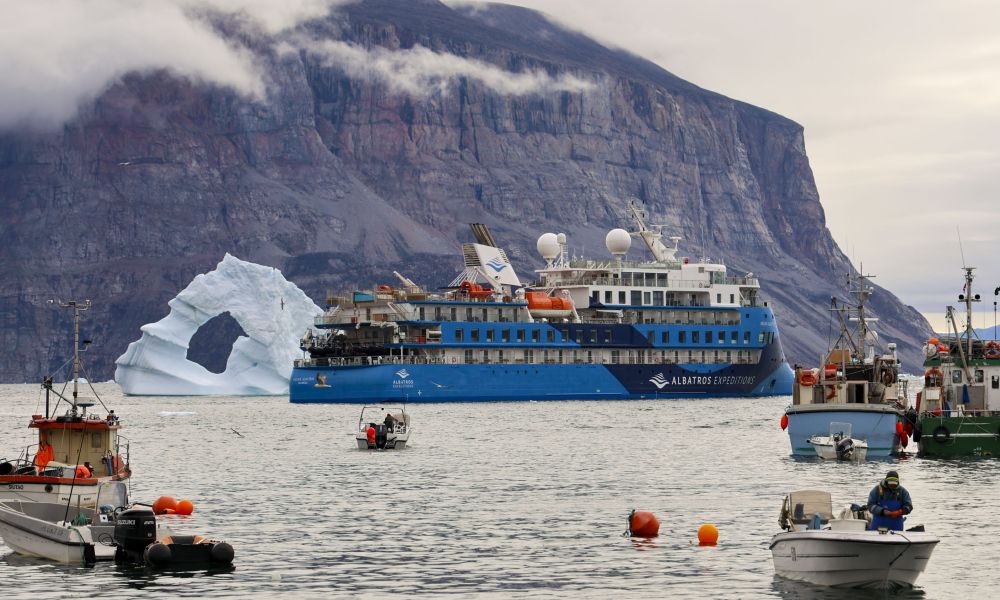
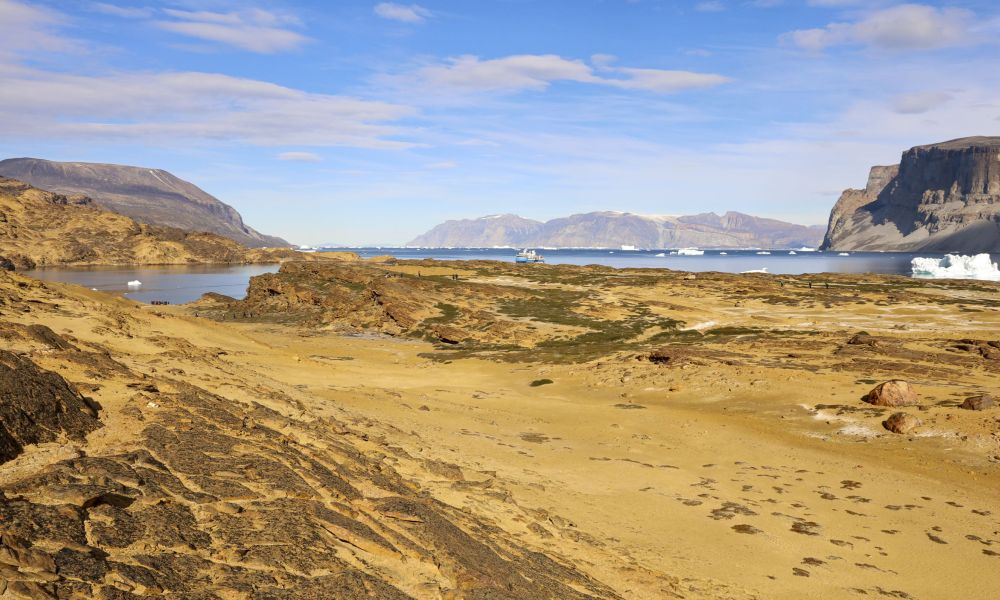
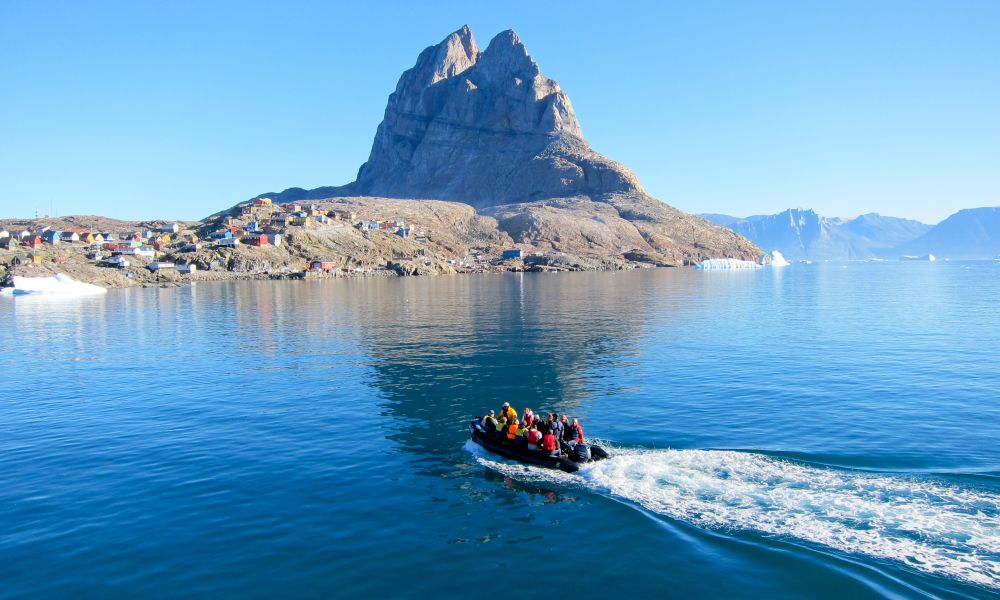
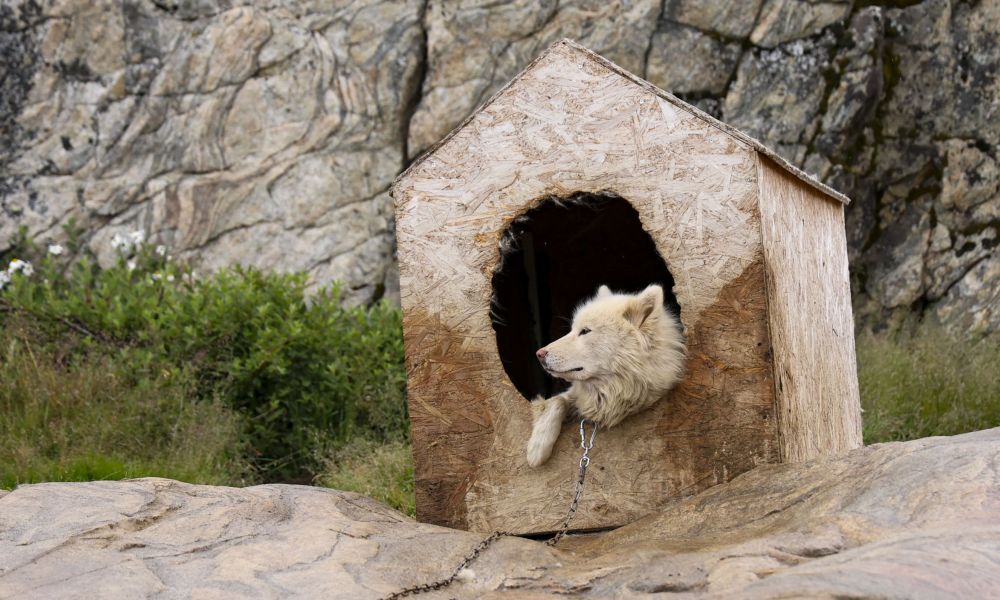
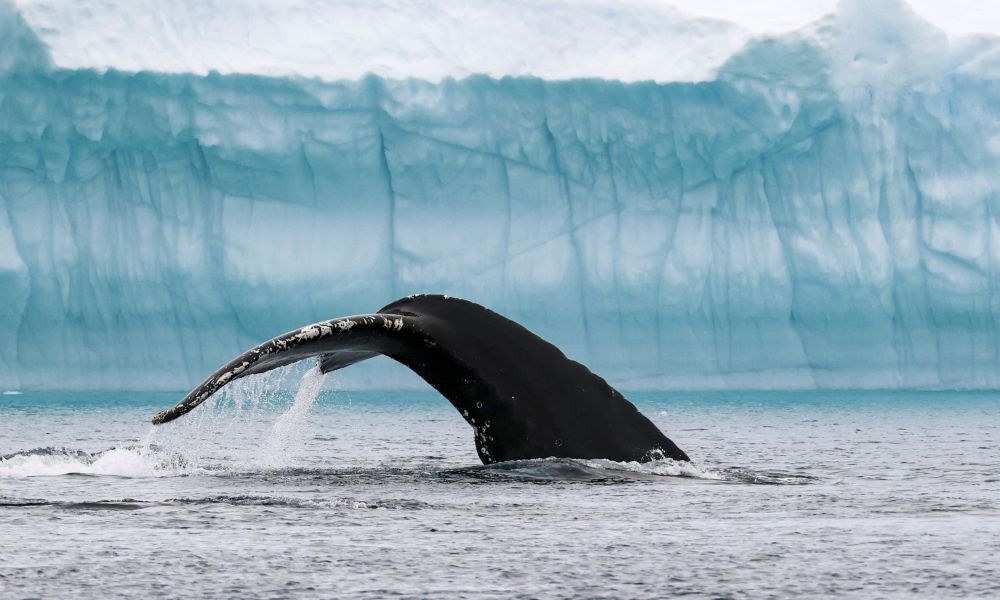
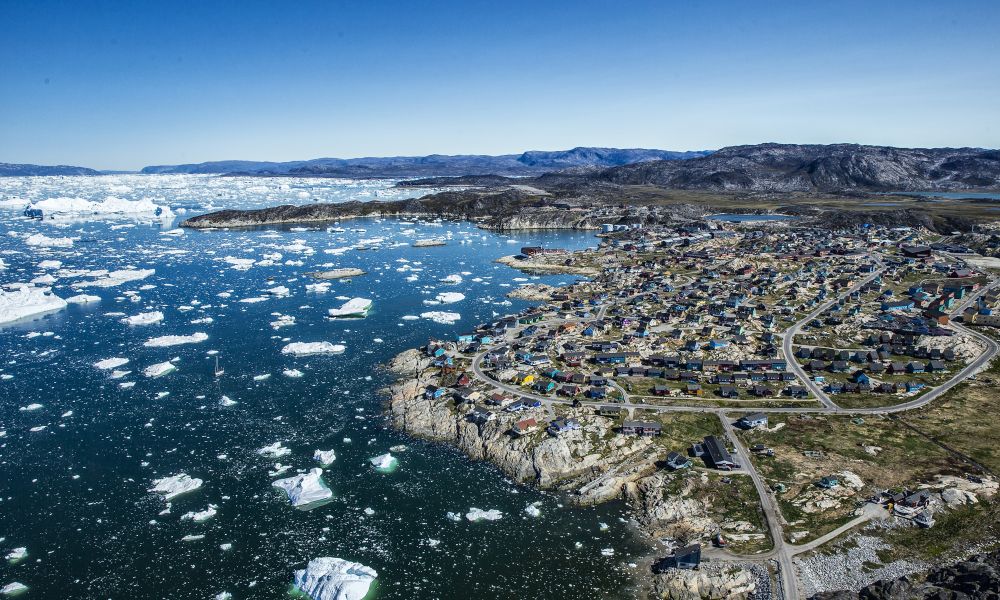
Day 1
Kangerlussuaq, Greenland
05.09.2026: On the first day of our expedition, we arrive in Kangerlussuaq on the west coast of Greenland, the hub for travel in this vast island.
Situated at the head of a 160km long fjord of the same name, Kangerlussuaq is Greenland's only inland town, and was established as Sondrestrom Air Base/Bluie West-8 by American troops in 1941. Existing largely to service the airport, the town of Kangerlussuaq itself retains a strong 'Cold War' feeling, hinting at its extensive American military use before it was signed over to the Greenlandic Government in 1992. Today Kangerlussuaq is Greenland's largest air hub, with flights arriving daily from Denmark and around the country. It's stable climate and lack of fog makes it ideal as an airport, but it exhibits some of the most varied temperatures in the country, commonly registering the highest summer and lowest winter temperatures due to its inland location.
Upon arrival in Kangerlussuaq, you will be transported to the small port located west of the airport, where the Ocean Albatros awaits at anchor. Zodiacs will transfer us the short distance to the ship, where you will be checked in to your stateroom. After the mandatory safety drill, enjoy dinner and a glass of champagne as we set sail a course for adventure through the 160-kilometre Kangerlussuaq fjord.
14.09.2026: On the first day of your expedition, you will arrive in Nuuk, the vibrant bustling capital of Greenland. Nuuk offers a huge amount to the discerning visitor; larger than any other city in Greenland, Nuuk has a bustling cosmopolitan vibe, and hosts some of Greenland's best attractions. Swing by Kolonihavn district to visit the Greenlandic National Museum, a treasure trove of history stretching back to the first inhabitants of this icy island - including artefacts from the Paleo-Inuit and Norse periods, as well as the spellbinding Qilakistoq mummies. Explore Greenlandic culture at Katuaq, the city's cultural centre and an architectural marvel; shop for authentic Greenlandic artworks in the city's many boutique shops, or simply relax at a hip curbside café with a Greenlandic coffee and watch this vibrant city in action. Nuuk York (as proud locals call it) is unlike any other city in Greenland, or indeed the world.
Day 2
Sisimiut, Greenland's Second City
After breakfast, Ocean Albatros will arrive in the colourful city of Sisimiut. With around 5,400 inhabitants, it is Greenland’s second largest city, and one of the most interesting to explore. Paleo-Inuit people have lived around Sisimiut on and off since 2,500 BC, arriving in waves of migration from Arctic Canada. Remnants of turf huts and tent camps from this time can be found thorughout the vast back country which surrounds Sisimiut, including on Tele Island, a short pleasant walk from the harbour.
In 1756, Count Johan Ludvig Holstein established a colony here and called it “Holsteinsborg”. The oldest part of Sisimiut features town houses from this era, and the oldest dates back to 1756. One of the most culturally significant buildings is the Blue Church, built in 1775, now a landmark in the city’s historical museum district, arguably the best preserved in Greenland, and the perfect place to discover the Greenland of old.
Nowadays, Sisimiut is an important hub of education and industry, and local factories process the bulk of fish caught in the country (Greenland’s largest export). The fish processing plant in the harbour is one of the largest in Greenland, and among the most modern in the world. Just beyond the harbour sits the headquarters of KNI, the government-operated company which resupplies the many small settlements throughout Greenland - a vital service in a country with so many remote communties.
The busy city centre of Sisimiut offers a glimpse of what daily life is like in 21st-century Greenland, where seal hunts and smartphones collide. Take a refreshing stroll around Spedjesø and take in an exhibition at the city's cultural centre Taseralik, explore the region's fascinating heritage at the city museum, or visit the Artists Workshop, where savvy shoppers can purchase traditional artworks direct from the artist. As evening falls, we will leave Sisimiut and set a course for the iceberg studded waters of Disko Bay (Qeqertarsuup Tunua) as Ocean Albatros sails for Qeqertarsuaq.
Day 3
Qeqertarsuaq, Disko Island
Nestled below Disko Island’s 1,000-metre mountains, we pull into port in a beautifully sheltered natural harbour. The place was aptly named Godhavn (“Good Harbour”) in Danish, while its Greenlandic name “Qeqertarsuaq” simply means “The Big Island”.
For most of Greenland’s modern history, Godhavn was the political and economic capital of North Greenland (while Godthåb, now Nuuk, served this role in Southern Greenland). Its importance was due to the vast economic activity generated by whaling in Disko Bay, the preeminent Arctic industry since the 16th Century. As the whaling industry collapsed in the early 1900s, Godhavn lost its political status as all government functions moved south to Godthåb/Nuuk, and the town was forced to reinvent itself, changing its name to Qeqertarsuaq in 1979 . Today, hunting and fishing are the main industries in Qeqertarsuaq, while tourism is becoming increasingly important. Ferries arrive in the town daily in summer from around Disko Bay, while in winter, access is only by helicopter from nearby Ilulissat.
Qeqertarsuaq’s sweeping red-and-black basalt mountains are radically different to the rolling granite hills which characterize much of Greenland, and provide a much richer soil. Despite being situated well above the Arctic Circle, this rich volcanic soil and the area’s mild microclimate make it much more green and lush compared to the rest of the country. Locals from all over Disko Bay come to the island in summer to hunt and collect angelica, herbs and mushrooms, and the stunning rock formations and black sand beaches attract visitors from all over the world. The town itself is typically Greenlandic, with quaint multicoloured homes, a splendid museum, and the unique octagonal church nicknamed 'God's Inkpot' (built in the Norwegian stave style). With excellent hiking opportunities, friendly locals, and a fascinating place in regional history, Qeqertarsuaq has a lot to offer.
On the afternoon of our day on Disko Island, we will reposition our vessel slightly to the east and launch our fleet of Zodiacs to explore the coast of Kuannit. Kuannit means 'Angelica' in Greenlandic, referring to the herb which grows abundantly on the rich south-facing slopes of the island. This stretch of coastline is one of Greenland's best kept secrets; with lush greenery dripping with water from mountain springs, spectacularly weird basalt rock formations riddled with caves and waterfalls, and plenty of sapphire-blue icebergs, this secluded section of coast is one of the most spectacular in the Arctic.
From Kuannit, we will set a northerly course towards Uummannaq Fjord.
Day 4
Akulleq and Uummannaq Fjord
At the heart of the maze of islands and fjords north of Nuussuaq Peninsula lies Akulleq - an island whose name aptly translates as 'The Centre'. This island is a geological marvel, a slab of vivid yellow rock amid the crystal blue Arctic waters. The rock is billions of years old, although in this part of Greenland, the age is unremarkable. Understanding rocks of this age is incredibly challenging, however scientists believe that these unique rocks formed in the deep ocean floor, at a time when only single-celled life existed on planet Earth.
Akulleq offers a window into the geological past, as well as the unique ecology of this part of Greenland. Uninhabited and rarely visited, Akulleq is the ideal location to experience pristine Arctic nature. Hunt for tiny saxifrage flowers, watch icebergs drift past and feel billions of years of geological time beneath your feet on this lonely, barren yet beautiful island.
During the afternoon, we will be guided by the patterns of weather and ice as we hunt for a location to explore Uummannaq Fjord by Zodiac. Every corner of this vast fjord system holds jaw-dropping views, vast icebergs, and vibrant rock formations - perfect for exploring on the water!
Day 5
Uummannaq, the Greenlandic Riviera
The small city of Uummannaq sits perched precariously at the foot of a massive mountain. Like the rest of the area, here the mountain reaches vertically out of the icy depths, punching 1170m into the clear blue sky. Uummannaq mountain (translated from Greenlandic as “heart shaped”) is a true Greenlandic icon, and is a mecca for climbers who visit from all over the world. The city itself occupies a small area of flatter ground at the foot of the mountain, founded by Danish colonists in 1763 – some of the original buildings from this era can still be visited in the harbour-front area. More recently, Uummannaq has become famous in Scandinavia as the home of Santa Claus – the small turf house belonging to the festive hero himself can be reached via a pleasant (if challenging) 2-3h hike out of town.
As for many towns in Greenland however, the Inuit history of the area reaches back much further. At some point around the year 1600, a group of Inuit women and children died in the area (possibly in a boating accident). They were lovingly laid to rest in a rocky cairn under a cliff on the mainland overlooking Uummannaq at a site called Qilakitsoq, protected from the rain and snow, but exposed to the dry Arctic wind which mummified their bodies. They were rediscovered in 1972 by two brothers from Uummannaq (possibly on the advice of elders in Uummannaq, who had preserved rumours of the site for centuries). The mummies were taken to Denmark for analysis before being returned to Greenland, where today they rest in the National Museum in Nuuk. The small museum in Uummannaq did not have the facilities to house such an important find, but several artefacts such as clothing from the archaeological site (as well as a plethora of finds from before, during and after the Qilakitsoq period) are displayed, along with a cabinet of curiosities from the city’s brief mining boom.
Uummannaq itself is a lively little town. Expect to see enterprising locals selling handicrafts in the grassy town square, while others sell their catch in the local fish market - always a fascinating sight. Watch fishermen bait their long lines as they head out in search of halibut, or load up with provisions for hunting trips deep into the vast fjordlands outside town.
Ensure you are on Ocean Albatros’ outer decks during our sail-out from Uummannaq – the deep clear blue iceberg-studded waters of the fjord and the dramatic vertical mountains around the city offer some of the best views in Greenland. With a calm microclimate and round-the-clock summer sunshine, not for nothing is this staggeringly beautiful area nicknamed the Greenlandic Riviera!
Day 6
Eqip Sermia
From Uummannaq, we return to the heart of Disko Bay, setting sail towards Eqip Sermia.
Eqip Sermia (a typically descriptive Greenlandic name meaning 'the Glacier at the End of the Fjord') is a relatively small glacier compared to many in Greenland, although it is still a truly vast river of ice, flowing directly from the Greenland Ice Sheet. It is also one of the most active, and ice tumbles off the vast glacier-front almost constantly. Watching the vast cataracts of ice fall into the ocean is a sight which has to be seen to be believed, and the comfortable viewing decks of Ocean Albatros offer the best possible platform to do so... Perhaps with a specially crafted cocktail in hand!
If conditions allow, we will launch our fleet of Zodiacs to approach this vast river of ice, and hopefully experience the roar of the glacier's frequent calvings at sea level (from a safe distance of course)!
From Eqip Sermia, we will reposition slightly southwards during the evening towards Ilulissat, the largest city in Disko Bay and the Iceberg Capital of the World.
Day 7
Ilulissat, Iceberg Capital of the World
This is it. This is why visitors from all over the world come to Greenland. Translated from Kalaallisut simply as ‘icebergs’, Ilulissat is rightly known the world over as ‘the Iceberg Capital of the World’. Surely no other city on Earth occupies such a spectacular natural setting.
Situated within a short walk of the harbour lies Ilulissat Icefjord, Greenland’s most famous site. Choked with city-sized icebergs so closely packed one could almost walk across to the other side, Ilulissat Icefjord stretches 70 km from its outlet in Disko Bay near the city of Ilulissat back to the Sermeq Kujalleq glacier. This is the single largest glacier on Earth outside Antarctica, draining 13% of the Greenland Ice Sheet, and producing 10% of all the ice in the Northern Hemisphere (enough water to supply the annual needs of the entire United States). These mind-blowing statistics, together with the indescribably beautiful scenery, have secured the Ilulissat Icefjord designation as a UNESCO World Heritage Site.
While archaeological finds detail the long Inuit habitation of the area, the modern town has steadily flourished in the 280 years since its establishment; legendary Arctic explorer, Knud Rasmussen was born in Ilulissat, and his childhood home now houses the city museum. Today, Ilulissat is Greenland’s third largest town, with more than 4,500 inhabitants, and is undoubtedly Greenland’s tourism capital, with more hotel rooms than even Nuuk. The city offers excellent amenities to visitors, with fresh locally caught seafood served in the city’s cafes and restaurants, and excellent shopping – look out especially for the Artist’s Workshop above the harbour, where you can buy handmade artworks direct from the artist. The city typically experiences dry sunny weather throughout the summer, and there are a variety of well-marked hiking routes around the Icefjord, with options to suit all abilities.
During the visit you will have the opportunity to join a boat trip with a local captain to the Icefjord (optional excursion – charge applies). The journey takes about two and a half hours and is considered the best way to experience the magic of Ilulissat Icefjord up close. If a hike or a trip by boat does not present enough excitement, there is also the opportunity to join a flightseeing excursion in fixed-wing aircraft over the Icefjord (optional excursion – charge applies).
Please note the boat and flight excursions to the Icefjord are not included in the general voyage price. Refer to Price Information for further details.
Day 8
Itilleq - experience small-town Greenland
The settlement of Itilleq, which translates roughly as "the Crossing Place from the Sea” nestles at the foothills of the mountains and and fjords which line central Greenland's backcountry. Situated just north of the Arctic Circle, Itilleq is one of the many tiny villages dotting the coast of Greenland. The settlement is situated in the heart of the Aassivisuit-Nipisat UNESCO World Heritage Site, which was inscribed due to its ancient Inuit hunting heritage, documenting the entire habitation history of Greenland.
While the turf houses and hide tents have been replaced by colourful modern houses, the lifestyle here has changes little since the Inuit first arrived in Greenland. The local highways are the water and the ice, and the sea and tundra continue to nourish the locals, as they has for thousands of years. Arctic char, reindeer and muskoxen are typical catches, and are all plentiful in the area.
Despite this ancient heritage, locals in Itilleq are still firmly in the modern world, with smartphones, speedy wifi and satellite TV. However, the people of Itilleq remain justly proud of their ancient heritage, and continue to move their culture forward in a modern fast paced world. Locals are pleased to show off their piucturesque town, and visitors are greeted with typical warm Greenlandic hospitality.
Day 9
Kangaamiut and Evighedsfjorden
On the next day of our expedition, we will arrive at the small village of Kangaamiut, an incredibly picturesque settlement in Greenland’s central Qeqqata region. Surrounded by cold rich waters and a vast back country brimming with game, life in Kangaamiut moves at a slower pace, and locals still live a largely traditional lifestyle, surviving by hunting and fishing. Hike to the heliport atop the hill for stunning views over the town and the surrounding fjordlands, or meet the friendly local people during a display of traditional clothing, foods, and seal-flensing. The artists of Kangaamiut are well-known throughout Greenland, and some of the locals' most splendid work can be viewed in the town's small museum.
In the afternoon, we will sail inland into Evighedsfjorden/Kangerlussuatsiaq, one of the many deep fjords carved between the steep mountains of this region. The Danish name 'Evighedsfjorden' means 'The Eternity Fjord', referring to the vast size of the inlet, while the Greenlandic name 'Kangerlussuatsiaq' translates as 'The Rather Large Fjord' - something of an understatement! Evighedsfjorden stretches around 100km into the glacier-clad mountains, bisecting the large ice cap which overlies much of the land between Nuuk and Sisimiut - Greenland's two largest cities. We will aim to explore on a Zodiac cruise in front of the Evigheds Glacier, which flows into the fjord from the Maniitsoq Ice Cap above. Watch for calvings from the glacier, and guillemots and kittiwakes on the nearby bird cliffs.
Day 10
Nuuk, Greenland - Disembarkation
On the final day of our voyage, we arrive in Nuuk, Greenland's small but perfectly formed capital city. A mixture of skyscrapers and traditional wooden houses, the quaint and the cosmopolitan, Nuuk is a city of contrasts. The vibrant bustling capital of Greenland, Nuuk feels much larger than it’s 19,000 inhabitants, and offers a wealth of experiences to visitors.
After a hearty breakfast, it is time to bid a fond farewell to the Crew and Albatros Expedition Team, and descend the gangway back to dry land with memories of the voyage of a lifetime.
Inclusions
New Inclusions: Arctic 2026
- Mandatory one-way transfer package: includes flight Copenhagen to Kangerlussaq and group transfer Kangerlussaq airport to ship.
- 10-day/9-night shipboard ensuite accommodation in your selected and paid category and occupancy
- Complimentary use of Expedition Parka and rubber style muck boots, on loan for the duration of your expedition
- English-speaking Expedition Team
- Guided walks, nature hikes, Zodiac landings and excursions, as per itinerary, guided by our Expedition Team (excluding optional or activities with cost)
- Briefings and educational lectures by the Expedition Team
- Citizen Science Program
- All meals on on the ship (full board): breakfast, lunch, dinner and snacks
- Complimentary house wine, beer and soft drinks at dinner (selected labels and brands)
- 24 hours access to tea, coffee, and ‘Grab and Go’ comfort food
- Welcome and Farewell Cocktail Parties
- Taxes and landing fees
- 500MB Complimentary WiFi for use on your personal device
- Digital Expedition Memento , including a curated selection of photos, videos, expedition log and map, and wildlife list
- Exclusive Suite Inclusions: Available on Ocean Albatros: Junior Suite (Cat A), Balcony Suite (Cat B), Brynhilde Suite & Freydis Suite only, and Ocean Victory: Junior Suite (Cat A), Balcony Suite (Cat B) & Freydis Suite only: Wine and fruit platter on arrival, restocked in-suite mini bar (non-alcoholic) and complimentary laundry service throughout your expedition
Exclusions
- International or internal airfares unless listed in the itinerary
- Excursions and activities not mentioned in the itinerary
- Meals and beverages not listed as included
- Voluntary gratuity for the crew and Expedition Team (we recommend USD 20 per person per day)
- Personal expenses such as spa services, boutique purchases, bar, laundry, communications unless specified
- Mandatory travel insurance (must meet mandatory minimum coverage requirements for medical treatment and evacuation)
- Visa, reciprocity and passport fees
- Medical care or emergency evacuation
- Expedition Jacket and rubber muck-style boots outside of available sizes. Please enquire for more details.
- Life jackets for selected minors. Please enquire for more details.
- Anything not mentioned under ’Inclusions”
After leaving the airport town of Kangerlussuaq, your expedition vessel will proceed onwards into Greenland to explore the unknown. The goal for the days spent exploring in Greenland is to offer activities which will allow everyone to explore off the ship as much as possible, and experience the nature, settlements and culture of Greenland in person.
Our activities in Greenland will vary widely according to the nature of the locations we visit – some larger settlements need an entire day to explore, whereas some smaller villages can be seen in a few hours. Greenland is Earth’s largest island, and on any itinerary in this region, travel time between destinations can be significant. Activities we offer include landings, Zodiac cruises and ship cruises. Regulations in Greenland limit the number of people ashore at any time at certain natural and historical sites, so we will usually aim to offer a Zodiac cruise while our first group of guests are ashore, and reverse this for the second group ashore to maximise exploration time where numerical limits apply. In towns and cities where the environment is less sensitive, there are no limits on numbers of people ashore. No matter the day’s planned activities, the onboard Expedition Team and Expedition Leader will work as hard as possible in conjunction with the Captain and Crew to maximize exploration opportunities.
A “typical” expedition day in Greenland may look like this (subject to weather and sea conditions and sailing schedule):
- 0645: Wake-up call
- 07.00-08.00: Breakfast
- 08.30-11.30: Morning activity – arrival in port at anchor, Zodiac ashore to explore Greenlandic settlements, historical sites etc. Depending on the location, we may spend the whole day in port.
- 12.30-13.30: Lunch onboard
- 1430-17.30: Afternoon Activity – Either in connection with the morning, or at a different site, depending on itinerary
- 18.30-1930: Evening Recap with Expedition Team
- 19.30: Dinner
Landings are a great opportunity to stretch your legs and set foot on shore to visit the towns and cities of Greenland and experience Arctic nature first-hand. Our experienced Expedition Team will be on shore to help you spot any wildlife, identify the different species of birds and mammals, guide you through Greenlandic settlements, as well as keep our guests safe on shore from any potential hazards.
We remind our guests that Greenland is a truly wild destination, to consider their physical capability when travelling in the country. In smaller towns and villages, infrastructure for tourism may be less well developed than in other destinations. Most smaller towns and villages lack step-free access, and roads and paths can often be steep and uneven.
Some sites do not offer landing opportunities, but are locations where exploring on the water offers the best opportunities for sightseeing, wildlife and photography. These Zodiac cruise sites are often known for their concentration of ice, wildlife and even historical landmarks such as Inuit or Norse ruins, where our fleet of Zodiacs offer the best vantage point. This would be the only scenario you may have to wait on the ship (other than in adverse weather conditions), but we will always aim to offer an onboard program during this time, such as seminars given by our knowledgeable and experienced Lecturer team. Zodiac cruises are great for observing icebergs, glaciers, whales, and other marine wildlife. Your skilled driver will navigate around the area looking for wildlife and beautiful landscapes. By the end of the voyage, Zodiac cruises tend to become a firm favourite among our guests because of the vast diversity of scenery and marine life it is possible to experience.
In the event we encounter bad weather or are in a particularly spectacular location, often our purpose-built expedition vessels are the best viewing platform. The Captain and Expedition Leader will search for locations best accessed with the vessel to seek out the best wildlife and scenery. We encourage everyone to bundle up and either head onto the outer decks with the Expedition Team or relax in superlative comfort in our specially-designed lounges to experience the majesty of the Arctic from the best vantage point. During this time, our Expedition Team specialists will offer skillfully-crafted lectures related to the wildlife, history, culture and conservation of the region, and more!
Other activities onboard include our ship Gym, where you can burn some calories on our fitness bicycles or treadmills; most of our ships even have other cardio machines and strength/lifting options. Most voyages throughout the season also offer kayaking (booked and paid onboard – weather permitting), and we will often aim to offer hiking excursions onshore when possible. Our new purpose-built ships have a Spa, in which guests can enjoy massages, facials, and other relaxing treatments (additional cost applies). Our Library is a great place to rest between outings, with expansive views and a wide selection of Arctic-related reading material. During your voyage you will also be able to enjoy our tea time in the late afternoon, or indulge in some retail therapy in our onboard shop, which sells personal necessities as well as specially-selected Arctic souvenirs.
In between our landings and activities we offer three hearty daily main meals. Albatros Expeditions always have allergy flexible options, healthy selections as well as a variety of vegetarian and vegan options.
Our hardworking galley crew deliver multiple Breakfast options, served in a buffet style along with a cooking station where eggs are made to order. At Lunch we are also met with a smorgasbord of mouthwatering choices. Safe to say you will have the energy for your next outing!
When it is Dinner time, you can choose to eat at the main restaurant or book a table at the Specialty Restaurant. Your evening meal is served a la carte, with fresh new options daily and always a selection of fixed items. There is always a vegetarian and pescetarian option available. Albatros Expeditions are known for our delicious menus and a variety of exquisite wine pairings.
Onboard you will also have the option to join Afternoon Tea with sweets, cakes or snacks served each afternoon. Albatros Expeditions have tea and coffee freely available all day throughout the vessel, while specialty coffee, alcoholic beverages and hand-crafted cocktails are available at the ship’s bars.
Spring comes late to Greenland, due to its challenging polar climate. During June, migratory wildlife begins to return to Greenland. Geese, wading birds, and seabirds arrive for their breeding season, constructing nests and defending their tiny but all-important territories. While Greenland experiences the midnight sun from May to August, during June, many of the fjords are still frozen, and snow reaches down to the sea. This cold and unpredictable weather can hamper exploration at times.
By July, Greenland begins to come to life. The tundra begins to come to life, as saxifrages, Arctic willows and heathers start to green the otherwise stark Arctic landscape. Flowers bloom in the brief Arctic summer, rotating through the day to follow the precious sunlight. In wilderness areas, muskox and reindeer can be seen grazing on the fresh greenery, while inhabited locations burst to life. Locals in Greenland take advantage of the brief summer to harvest the ocean’s riches, and summer is prime fishing season. Conditions during July tend to be settled, with calm sunny days the norm (although beware of the mosquitos in windless areas)! Expect to meet plenty of locals – July is the middle of the summer holiday, so expect to see Greenlandic children enjoying their freedom on their bikes and skateboards. Many locals pivot to working in tourism during the brief summer season; even small towns can be bustling when a vessel visits!
August is the peak of the Arctic summer, with long sunny days – although the evenings start to draw in, with several hours of darkness by the end of the month. August is prime hunting season in Greenland – depending on the day, some settlements can be almost empty, with almost all locals heading into the wilderness to hunt reindeer, seals and muskox. Expect to see the fruits of these hunts for sale in local markets, usually proudly sold by local hunters. August is also peak trout season, so expect to see fish hung up to dry around towns and villages, or being smoked in small turf ovens. Most chicks have begun to fledge by this point, and are starting to leave the nest; for cliff-nesting species, this involves a terrifying leap off their nest into the sea – often known as ‘jumping season’. On land, the tundra plants are moving rapidly through their life cycle, and tart crowberries and delicious blueberries are almost everywhere – expect to see locals young and old alike gathering this delectable bounty; some is eaten as-is or used in baking, and the rest frozen to enjoy during the long winter.
The tundra is at its brightest during September, as the willows, then the saxifrages and heathers begin to show their autumn colours; an autumn forest in miniature! During September, the weather in the North Atlantic can become more challenging and wild, giving an even more rugged cast to this spectacular island. September marks the return of true dark nights to Greenland as autumn sets in. Frosts and even snow showers can occur this time of year, although the longer nights also offer a tantalising chance to see the Northern Lights. This time of year, most migratory birds are starting to head south or out to the open ocean for the winter, so expect to see a variety of birds of all ages heading to sea for winter.
Greenland is a vast island, stretching almost 3000km from north to south. The climate throughout Greenland is subsequently hugely varied, reflecting the variation in latitude.
Greenland’s west coast (including the Disko Bay region) tend to have a cooler but more stable climate than the south of the country. Expect temperatures between 8-12°C (46-54°F). These temperatures can be exceeded in sheltered areas, especially far up fjords – Kangerlussuaq, situated 160km inland for instance regularly records summer temperatures in excess of 20°C/68°F. The weather is generally calm and sunny, although cool rainy or foggy days do occur. It is very rare for snowfall or sub-zero temperatures to occur in summer, although this does occasionally happen.
We therefore remind our guests to be prepared for all weather conditions! We highly recommend to our guests to dress in layers (ideally in woolen or synthetic fibers) and a backpack so that layers can be adjusted as the weather dictates. Warm/waterproof layers, hats, waterproof gloves and scarves are recommended for all excursions off the vessel, even on the sunniest days – the weather can deteriorate rapidly at any time. Sun protection (hats, sunglasses, sunscreen and lip balm) is also essential – the low angle of the Arctic sun combined with cool ambient temperatures can cause sunburn to easily go unnoticed until it is too late!
Despite it's high latitude and cold weather, mosquitos and other insects can cause a real nuisance in Greenland during summer. Head nets, long sleeved clothing and repellant are essential for a comfortable experience in Greenland, and we highly advise guests joining this voyage to ensure they prepare for encounters with these tiny irritating Arctic animals!
Albatros Expedition strives to employ the very best Expedition Team in the whole industry. We travel in some of the planet’s most remote regions, where planning and on-location experience is key. Our routes and itineraries are subject to the prevailing sea, ice and wind conditions, which are closely monitored by the Bridge Team and Expedition Leader. Drawing on their vast experience, they find the best alternatives in the rare instances where our planned itinerary needs to be changed. Each cruise is a completely unique combination of locations, where the highlights can often be the totally unexpected. Most of our cruises provide the opportunity to spot a variety of unique wildlife, although this is subject to the whims of Mother Nature and can of course not be guaranteed. As you will no doubt experience, the joy from our Expedition Team when spotting different species on land or at sea is as genuine as your own.
This means that you as our guest are part of an adventure, a true expedition, where plans change, wildlife is encountered on their terms and your team consists of the very best experts within their fields. We strive to maintain a mix of specialists within relevant polar subjects including marine biology, ornithology, earth science, history and others. Albatros Expeditions boast a large number of Expedition Staff onboard, allowing us to maintain a high ratio of staff-to-guests at 1:8, amongst the highest ratios in expedition cruising. Some of our staff have decades of experience on ships or research stations, whilst others may be performing their first season. One thing they all have in common is the wish to make each and every journey a special and memorable experience for our guests. Knowledge, skill, and passion are the trademarks of all Albatros Expedition Staff.
To ensure the safety and quality of experience of our guests, please keep in mind that the itinerary and outdoor activities during each voyage are solely dependent on weather and sea conditions. Your safety is our highest priority. The route and shore landings will be determined by the Captain and Expedition Leader and communicated to guests through regularly scheduled briefings. Albatros Expeditions reserves the right to modify the landings and locations visited during a voyage based on local weather conditions and climate to ensure a safe and enjoyable experience for all our guests. Our voyages are expeditionary in nature, and thus changes to timings are commonplace due to the environment we operate in, as well as wildlife opportunities and locations.



